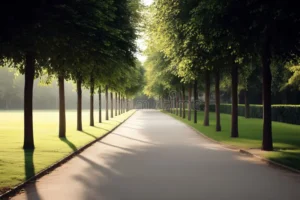In his Eyeo talk, Casey Reas reflects on how randomness can bring life to a system. At one point, he explains that when there is no variation or unpredictability, everything begins to merge into sameness: “If these lines don’t have any bit of noise or jitter, they gradually tend towards one location. The system becomes homogeneous.” I found this idea so powerful because it mirrors real life. If everything was perfectly controlled, predictable, and identical, the world would feel lifeless. For example, if every tree on my walking path looked exactly the same, going on a walk would be dull and uninspiring. But because there’s always a little difference like a twisted branch, a bird flying by or sudden shift in light , my walk is always interesting and dynamic. Reas’ point about adding just a “slight bit of noise” to keep a system alive reminds me that unpredictability is what makes both art and life vibrant. I completely agree with his perspective that randomness doesn’t need to feel chaotic; instead, it can be a natural force that keeps things intriguing and gives them life, much like nature itself.
Reas also talks about the tension between chaos and order in art, saying that historically artists have been expected to impose structure and fight against disorder. His work flips that expectation, showing that embracing randomness doesn’t mean giving up control. He designs rules and systems but leaves certain spaces open for chance, allowing surprising outcomes to emerge. This balance really resonates with me. I’ve noticed in my own creative work that when I try to control every single detail, the result feels rigid and forced, it almost seems as if it traps my flow of creativity. On the other hand, if I let go completely, the work fully loses direction and structure. I think the “optimum balance,” as Reas demonstrates, is to create a strong foundation, like the rules of a game, and then allow randomness to bring it to life. This makes me rethink how I approach creativity. Rather than seeing unpredictability as a threat, I want to treat it as a collaborator, trusting that a little randomness will make my work interesting and lively, just as it makes the world around us more beautiful and alive.
Casey Reas’ talk really resonated with me because I go on walks all the time, and I’ve noticed how much the environment affects how I feel. The first photo, with its perfectly symmetrical path and identical trees, reminds me of walking on a treadmill at the gym, predictable and boring. But the second photo, with its uneven, colorful flowers and natural variety, captures what makes walking outside so special to me. The flowers aren’t perfectly placed, yet that imperfection gives the path life and personality. It doesn’t feel chaotic, just alive, and that’s what keeps my walks meaningful and exciting.


